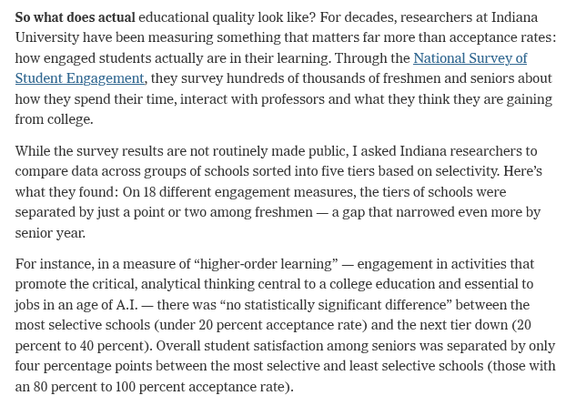GLAT: The generative AI literacy assessment test https://www.sciencedirect.com/science/article/pii/S2666920X25000761?via%3Dihub
The questions used are in the article. It's also here, but the site didn't work for me https://www.glat.ai/GLAT
Presentation by co-author https://youtu.be/2sNTxu33Xw4?si=93tDIPkgmhQM2kd4
More about #AILiteracy https://theconversation.com/ai-literacy-what-it-is-what-it-isnt-who-needs-it-and-why-its-hard-to-define-256061
#AIEd #EdTech
Faculty/Educational Developer, #EdDev #FacDev #Education #Learning #Teaching #EdTech #HigherEd #StudentSuccess #EdResearch #STEMeducation #LearningSciences #LearningDesign #OnlineLearning #OpenSource #OER
An AI chatbot’s feedback style can alter your brain activity during learning https://www.psypost.org/an-ai-chatbots-feedback-style-can-alter-your-brain-activity-during-learning/?utm_source=dlvr.it&utm_medium=mastodon
Cool demo by @TodePond of a classroom agent in @tldraw
https://youtu.be/L-fKtZXDb-s?si=OEoYVRaxfEXwljWP
Jump to the 10 minute mark to see an example of AI giving guidance to a student working on a math problem on the tldraw digital whiteboard/canvas. Uses the agent starter kit https://tldraw.dev/starter-kits/agent
#AIEd #EdTech #MathEd #tldraw
@rhettallain yeah I tried getting ChatGPT and Gemini to generate graphs that correspond to calculus problems and it was pretty bad. I think code generation, Python plotting might work better, but haven't tried it, and that's not so accessible for students
This framing gets it. Assessment in the AI era isn’t a puzzle to solve; it’s a balancing act we’ll never finish. We should expect messiness and make space for it institutionally.
https://onedtech.philhillaa.com/p/on-flexibility-in-teaching-learning-and-edtech
A principled way to think about AI in education: guidance for action based on goals, models of human learning, and use of technologies
Noah D. Finkelstein
https://arxiv.org/abs/2510.01467 https://arxiv.org/pdf/2510.01467 https://arxiv.org/html/2510.01467
arXiv:2510.01467v1 Announce Type: new
Abstract: The rapid emergence of generative artificial intelligence (AI) and related technologies has the potential to dramatically influence higher education, raising questions about the roles of institutions, educators, and students in a technology-rich future. While existing discourse often emphasizes either the promise and peril of AI or its immediate implementation, this paper advances a third path: a principled framework for guiding the use of AI in teaching and learning. Drawing on decades of scholarship in the learning sciences and uses of technology in education, I articulate a set of principles that connect broad our educational goalsto actionable practices. These principles clarify the respective roles of educators, learners, and technologies in shaping curricula, designing instruction, assessing learning, and cultivating community. The piece illustrates how a principled approach enables higher education to harness new tools while preserving its fundamental mission: advancing meaningful learning, supporting democratic societies, and preparing students for dynamic futures. Ultimately, this framework seeks to ensure that AI augments rather than displaces human capacities, aligning technology use with enduring educational values and goals.
toXiv_bot_toot
A couple of sample #NotebookLM notebooks related to #AIEd:
* The Nature and Mitigation of AI Sycophancy https://notebooklm.google.com/notebook/27e7fbd9-8dcc-43f0-8156-b64c25ba380c including a note (under Studio tab) on implications for college #teaching
* College Success (OpenStax textbook) https://notebooklm.google.com/notebook/3aa47a4d-ed3c-4c73-b11e-793d8ce95627
You could upload your textbook (if #OER ) or course notes and share the link with your students to make a course-specific AI resource. While not required, Gemini Pro is free for a year for students https://gemini.google/students/
#EdTech
It should be obvious a priori that it's absurd to judge colleges by the number of applicants they manage to avoid admitting. Quality ≠ selectivity! Now there's evidence demonstrating the absence of an empirical relationship between the degree of intellectual engagement at a school and that school's selectivity: https://www.nytimes.com/2025/09/22/opinion/college-admissions-seniors-stats.html?unlocked_article_code=1.p08.cAi8.6Z5sK6-y-uuD&smid=url-share
Notes and system instructions and deep research reports on creating a custom GPT or Gemini Gem to tutor calculus: https://docs.google.com/document/d/1p2aeeVmstAASRUsgH52NLDmhghrhhsab2pvmyevnuYI/edit?usp=sharing
Hawkulus: AI Calculus Tutor (Custom GPT): https://chatgpt.com/g/g-68d992b987fc8191b6b394cb1dfd1593-hawkulus-precalculus-calculus-coach
Newton
Newton: Calculus Learning Coach (Gemini Gem): https://gemini.google.com/gem/1IojGkCEzOKL5o2w5ve-LEjZLCnFDTZwF?usp=sharing
#AIEd #MathEd
Asset-based Approaches to Student Success
https://edtechdev.wordpress.com/2025/10/01/asset/
In the past, I’ve shared strategies that have been shown to improve #StudentSuccess, but none of those are effective if we or our students have a fixed mindset (belief that intelligence is fixed) or deficit thinking (focusing on what students lack instead of what they bring to the table). The alternatives are growth mindset (intelligence can grow with effort) and asset-based approaches).
#EdDev #HigherEd #Teaching #EdReform
Teaching Tips: The First Major Exam or Assignment
https://edtechdev.wordpress.com/2025/09/26/first-exam/
A sampling of some research-based practices you may find useful for before, during, and after your first major assessment to improve student success and help struggling students turn things around afterward.
#EdDev #Teaching #HigherEd #StudentSuccess
A friend of mine is a professor who teaches CS and bioinformatics classes. She uploaded the wrong exam for her students, and a huge portion of them (like, 85% of the class) nailed material they had never seen before. Like, 100% quality work on Python or whatever (computers are just magic to me). And then one of the students asked what the deal was because they had never studied this stuff, and she got to learn that nearly all of her class was GPTing their way through it.
This looks interesting
LAMB - Learning Assistants Manager and Builder
"LAMB (Learning Assistants Manager and Builder) is an open-source web platform that enables educators to design, test, and publish AI-based learning assistants into your Learning Management System (LMS like #Moodle without writing any code."
Recent #AIEd articles:
* Collaborative Learning Activities For Promoting AI Literacy https://arxiv.org/abs/2508.15111v1
* Analyzing Problem-Solving in Physics Through Interaction With an AI Chatbot https://arxiv.org/abs/2508.14778v1
* MathBuddy: A Multimodal System for Affective Math Tutoring https://arxiv.org/abs/2508.19993v1 code: https://github.com/CleoChu/MathBuddy
* How Math Teachers Are Making Decisions About Using AI https://hai.stanford.edu/news/how-math-teachers-are-making-decisions-about-using-ai
* How does AI affect how we learn? https://thecognitivepsychologist.substack.com/p/how-does-ai-affect-how-we-learn-a
#EdTech #MathEd #AILiteracy
The myth of scientific objectivity hides the truth that every experiment is influenced by cultural values, assumptions and beliefs – and that actually hurts the search for truth
Using AI to create unlimited practice problems [in statistics] https://www.youtube.com/watch?v=tsmHmjBfGwI
https://chatgpt.com/g/g-67d1da836ac081918a789ee2ff7b80ae-statgpt?model=gpt-4o More on creating custom GPTs to generate problems https://edunewsletter.openai.com/p/teaching-with-chatgpt-personalized
They've also developed a custom tool that lets instructors see data on the way the students use it. Looking for instructors to test: https://pingpong.hks.harvard.edu/eduaccess
For a related open source project, see OnMicro for developing educational AI apps https://onmicro.ai/ https://github.com/onmicroai/micro_ai/tree/dev
#AIEd #EdTech #MathEd
Workado promoted its AI Content Detector as 98% accurate in detecting whether text was written by AI or a human. However, independent testing showed that the accuracy rate for general-purpose content was only 53%. The FTC alleges that Workado violated the FTC Act because the 98% claim was "false, misleading, or non-substantiated." https://nitter.net/LuizaJarovsky/status/1962973032588173449
More on the numerous problems and issues with AI detectors: https://dangerousaideas.substack.com/p/ai-detectors-in-education
#AIEd #AIDetection #EdTech #AIWashing
Evidence that AI is destroying jobs for young people
https://www.derekthompson.org/p/the-evidence-that-ai-is-destroying
Recent #AIEd articles:
* A Comprehensive Review of AI-based Intelligent Tutoring Systems https://arxiv.org/abs/2507.18882v1
* AI-Powered Math Tutoring: Platform for Personalized & Adaptive Education https://arxiv.org/abs/2507.12484v1
* Automatic LLM Creation of Interactive Learning Lessons https://arxiv.org/abs/2506.17356v1
* LearnLens: LLM-Enabled Personalised, Curriculum-Grounded Feedback with Educators in the Loop https://arxiv.org/abs/2507.04295v3
* AI Playbook for Teaching & Learning Leaders https://books.lib.uoguelph.ca/aiplaybook/
#EdTech #MathEd

